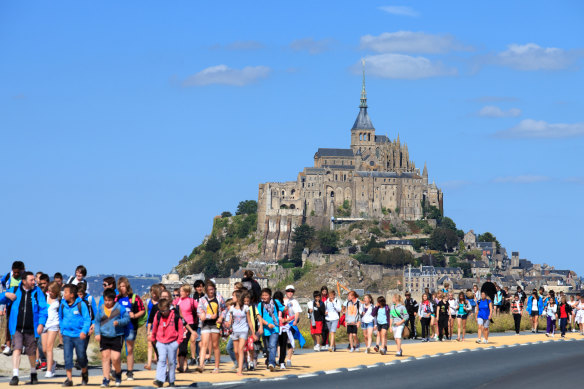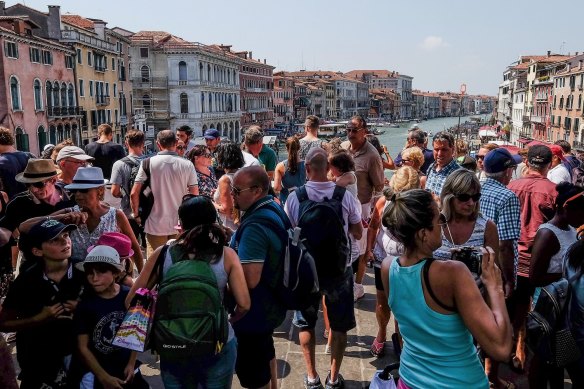Opinion
Travellers shouldn’t get the blame for ‘overtourism’. This is who is really at fault
Lee Tulloch
Travel columnistI’ll never forget my first sight of Mont Saint-Michel, the tidal island that sits off the coast of Normandy in France.
An eighth-century monastery tops the island and medieval streets wind their way to the spire on the abbey at the summit. Even though only 29 people call it home, the seven-hectare village attracts about three million visitors every year – about 8000 a day. Tourism is the major business, supporting about 50 shops.

Tourists swamp Mont Saint-Michel.Credit: iStock
The monastery is a striking sight, especially when the tide is out. But when I first saw it, back in the 1990s, the thing that stood out for me was the dozens of – maybe a hundred or more – campervans sitting in the car park across the causeway from the island. I found it abruptly disconcerting – this serene, medieval monastery rising out of the mudflats, looking like it was about to be invaded, not by Vikings, but by an army of holidaymakers in Winnebagos.
It’s still a very popular camping spot, especially with Brits, who flood off the Channel ferries to Normandy.
But perhaps not for long, if France’s tourism minister Olivia Gregoire has her way. Recently, she announced a plan to regulate visitors to popular sites such as Mont Saint-Michel and the beach town of Etretat, which are being overrun by tourists.
France, the world’s most popular tourist destination, has lost 30 per cent of its biodiversity in 35 years. An influx of people tramping on beaches, cliffs and natural habitats has contributed to this, according to the minister. The government is now encouraging people to visit alternative destinations or do it outside the peak tourist season.
Caps on numbers visiting certain places, tourist taxes and entry fees are all potentially part of the mix. Marseilles already limits visitors to its eroding cliffs to 400 a day.
France has heavily promoted its regions to tourists over the past decades. Not long ago it would have seen all these visitors as a success. But with the recent ban on short-haul flights within the country, which came into effect in May, France is starting to implement solutions to the environmental and social problems mass tourism is creating.
Elsewhere in Europe, many cities are introducing entry fees (Venice), traffic restrictions (Amalfi Coast), restricting short-term rental listings (Mallorca) and using apps to divert tourists to less busy locations (Amsterdam).
On the other side of the world, the local Bali government is weighing up a tourist tax and a tourist quota, spurred by a rash of incidents involving foreigners pushing the limits of tolerance by posing nude for photos, flouting traffic laws and abusing visa regulations.
Bali is one of many tourist-reliant destinations that faces a serious conundrum. Any kind of regulation risks discouraging visitors. But in many cases locals do not directly see much financial benefit from the dollars flooding into their destination – while experiencing all the inconveniences. The so-called benefits of tourism don’t trickle down if it’s not well-managed.
Interestingly, it’s the much-maligned backpacker who is the most valued traveller. Backpackers stay longer in a place and use local services.
That’s partly why “overtourism” has become an unpopular word. It puts the blame on the tourists when the real issue has been the poor management of destinations by governments, who have allowed tourist developments to destroy natural habitats such as mangrove forests, allowed cruise ships to disgorge thousands of passengers at a time into places that can barely sustain a few hundred, and have spent millions of dollars on tourism campaigns that see success in numbers rather than the quality of experience for everyone.
I’m wondering about the strategy, though. Venice’s €10 ($16.40) entry fee will supposedly dissuade day-trippers and help pay for collecting the garbage these travellers produce. The user-pays principle seems fair. But is it enough?

Tourists stand on the Rialto Bridge in Venice. Credit: Getty
In my case, I’d be happy to pay such a fee, anywhere, if it had some direct benefit to the community or environment. But an insignificant fee seems to be tinkering on the edge a bit.
It will be interesting to see how things work out this European summer, with cities like Venice reportedly more crowded than ever.
Maybe in the future we will have a much more regulated world where we need to join waiting lists for a walk across the Bridge of Sighs or on Waikiki beach, or pay for the privilege. But we will live with it.
If we don’t pay, someone else will. And that may be all of us in the end.
Sign up for the Traveller newsletter
The latest travel news, tips and inspiration delivered to your inbox. Sign up now.